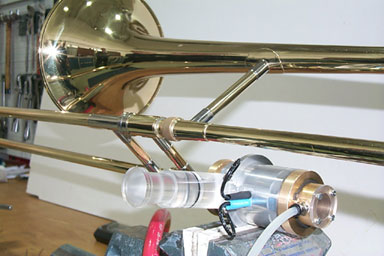Jol Gilbert - joel.gilbert@univ-lemans.fr
*Laboratoire d'Acoustique de l'Universit du Maine - UMR CNRS 6613
Avenue Olivier Messiaen,
72085 Le Mans Cedex 9
France
Popular version of paper 2aMU
Presented Tuesday, November 11, 2003
146th ASA Meeting, Austin, TX
At first sight, a wind musical instrument such a clarinet or a trombone seems to be a very straightforward acoustical device. But the reality is more complicated from the physicist's point of view and it is interesting to set up physical models in order to understand the behavior of wind instruments.
The development of realistic models of the interaction between the musician and the instrument is a tough task because of the difficulty of carrying out extensive measurements during music performance. It is not easy to put tranducers in the player's mouth without stopping him! To overcome this difficulty, mechanical devices called "artificial mouths" have been developed. If the artificial mouth for clarinets (see figure 1) developed in the nineties comes from first specimens built in the sixties, the artificial mouth for brass instruments (see figure 2) is more recent (work done within the context of a close collaboration with Jean-Franois Petiot, Ecole Centrale Nantes-France, and Murray Campbell, University of Edinburgh-Scotland). The crucial parts of the artificial mouth are the artificial lips (latex tubes filled with water), controlled by a plate behind them mimicking the jaw. In this way, analyzing how the lips and instrument interact is possible since the lips can be held in a fixed position for up to ten minutes ! Some significant progress on the understanding of vibrating lips behavior has thus been recently achieved. Although one can imagine that these kinds of artificial mouth could be improved and controlled so as to become a sort of musician's robot, it is not the aim of our studies. Nevertheless, besides the experimental studies to improve the physical modeling of wind instruments, we are developing other artificial mouths, "testing grounds" which permit us to make objective tests on instruments, in order to assist manufacturers.


Figure 1, a photo of the artificial mouth for clarinet. Figure 2, a photo of the artificial mouth for brasses.